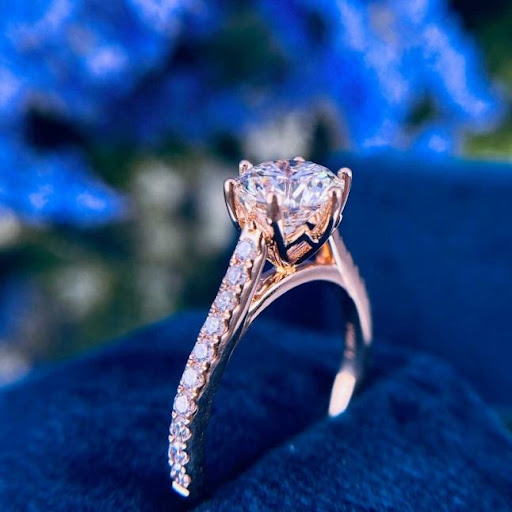
Choosing the proper jewel for your ring is a crucial decision, whether you're shopping for an engagement ring, an anniversary gift, or just for everyday use. Moissanite, diamond, and lab diamond are the three main options to consider.
Natural diamonds are formed over billions of years and are extracted from the earth. Man-made lab diamonds have the same material, crystal structure, durability, optical, and chemical qualities as natural diamonds. As a result, both natural and laboratory diamonds are regarded "genuine" diamonds. To tell them different, you'll need specialized equipment. Moissanite as we know it today was successfully synthesized for manufacture and is presently made in a laboratory. Despite the fact that both lab-grown diamonds and moissanite are man-made, they have quite different chemical makeups and characteristics when observed in person.
There is only a tiny variation in the durability of moissanite engagement rings and diamond engagement rings. This is also true in the case of a moissanite versus lab diamond comparison. Each one is extremely sturdy, almost scratch-resistant, and can sustain daily use. The only thing that can scratch a moissanite or diamond is another diamond, so as long as your stone does not come into direct contact with one, it should be alright. Testing hardness on different surfaces is not suggested, as applying pressure to a moissanite or diamond (lab grown or natural) might cause surface scratches. The Mohs Hardness Scale is used to assess the durability of gemstones. This scale evaluates a gem's ability to endure surface scratches in particular. On a scale of one to ten, the three gem selections are as follows:
Moissanite : Moissanite gemstones have a Mohs hardness rating of 9.25.
Natural Diamond : On the Mohs Scale of Hardness, natural diamonds are a ten.
Lab Diamond : On the Mohs Scale of Hardness, lab diamonds are a 10 on the scale.
The term brilliance is frequently used to describe the appearance of light reflected from a gem's interior. Moissanites offer a unique brilliance not found in diamonds. There is a difference in the brilliance of moissanite vs diamond rings and moissanite vs lab diamond rings, but there is no right or wrong answer. It all boils down to personal preference and/or financial constraints.
Moissanite : Moissanite gemstones have a rainbow-like sparkle to them. This increased brilliance has been compared to that of a little disco ball, and it shines brightest in direct sunshine.
Natural Diamond :Diamonds, whether natural or synthetic, reflect light in a variety of ways. The white light reflected by a diamond is its brilliance. The rainbow of hues reflected through a diamond is referred to as dispersion. Scintillation is the sparkle on a diamond's surface. Diamonds get their legendary gleam from a wonderful blend of these three elements.
Lab Diamond : Lab diamonds are made to emit light in the same way as genuine diamonds do
When looking at a gemstones, color refers to the natural hue, or lack of color, that may be perceived. There are variations between moissanite, diamonds, and lab diamonds, despite the fact that they appear to be extremely similar at first glance. A natural or lab diamond is an excellent alternative if you've always wanted a bright-white, clear diamond because they don't display any other hues. The color, or lack thereof, that you want your ring to show is typically at the heart of the moissanite vs diamond discussion.
Moissanite : Moissanite gemstones are frequently described as "colorless," however this isn't always the case. In some lights, they have a grayish or yellow color.
Natural Diamond : Diamonds have a dazzling white appearance that is due to their natural "colorless" color. A natural diamond, unlike moissanite, does not include any traces of gray or yellow.
Lab Diamonds : Like genuine diamonds, lab diamonds have a dazzling white color.
When deciding between moissanite engagement rings vs diamond engagement rings and a moissanite vs lab grown diamond, price is usually a decisive factor. Moissanite and lab-created diamonds are less expensive alternatives to genuine diamonds.
Moissanite : Moissanite gemstones are far less expensive than real diamonds. While a colorless 1-carat diamond would set you back around $5,000, a colorless 1-carat moissanite will set you back around $600.
Natural Diamond : Natural diamonds are the most expensive of the three gemstones options. The 4Cs of diamonds: cut, color, clarity, and carat determine the price of a diamond.
Lab Diamonds : Lab diamonds are less expensive than genuine diamonds, but they're a terrific option if you like the look of a diamond over a moissanite gem.
Sell your diamonds with ease with Diamond Registry’s comprehensive approach and vast global industry connections to help you find the best buyer for your diamond fast. Visit www.diamondregistry.com/sell-your-ring to take your first step to fast, easy and reliable way of selling your diamond.
Want to check and calculate diamond per carat instantly? Go to DR’s diamond price calculator www.diamondregistry.com/diamond-price-list/#calc-move-to to know how. Reliable and trusted carat calculator in the diamond industry since!

